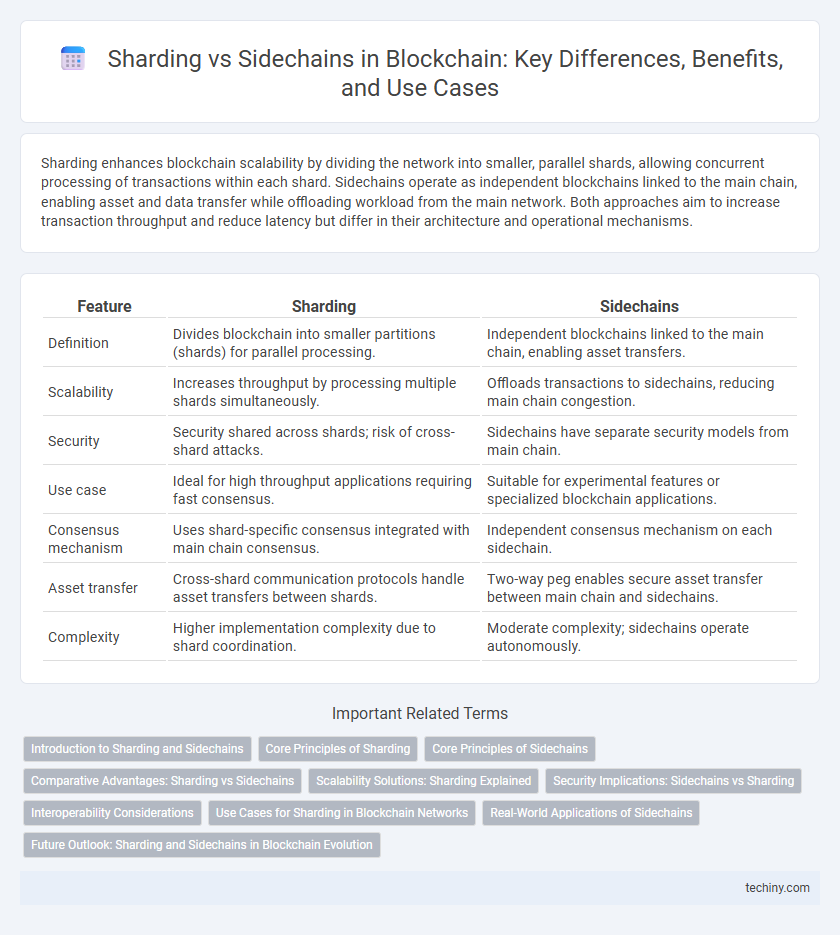Sharding enhances blockchain scalability by dividing the network into smaller, parallel shards, allowing concurrent processing of transactions within each shard. Sidechains operate as independent blockchains linked to the main chain, enabling asset and data transfer while offloading workload from the main network. Both approaches aim to increase transaction throughput and reduce latency but differ in their architecture and operational mechanisms.
Table of Comparison
| Feature | Sharding | Sidechains |
|---|---|---|
| Definition | Divides blockchain into smaller partitions (shards) for parallel processing. | Independent blockchains linked to the main chain, enabling asset transfers. |
| Scalability | Increases throughput by processing multiple shards simultaneously. | Offloads transactions to sidechains, reducing main chain congestion. |
| Security | Security shared across shards; risk of cross-shard attacks. | Sidechains have separate security models from main chain. |
| Use case | Ideal for high throughput applications requiring fast consensus. | Suitable for experimental features or specialized blockchain applications. |
| Consensus mechanism | Uses shard-specific consensus integrated with main chain consensus. | Independent consensus mechanism on each sidechain. |
| Asset transfer | Cross-shard communication protocols handle asset transfers between shards. | Two-way peg enables secure asset transfer between main chain and sidechains. |
| Complexity | Higher implementation complexity due to shard coordination. | Moderate complexity; sidechains operate autonomously. |
Introduction to Sharding and Sidechains
Sharding improves blockchain scalability by partitioning the ledger into smaller, manageable pieces called shards, allowing parallel transaction processing across multiple nodes. Sidechains operate as independent blockchains connected to the main chain, enabling asset transfers and customized functionalities without overloading the primary network. Both technologies address blockchain congestion but differ in architecture, with sharding enhancing internal data distribution and sidechains extending functionality through auxiliary chains.
Core Principles of Sharding
Sharding in blockchain involves partitioning the network into smaller, manageable segments called shards, each processing its own transactions and smart contracts to enhance scalability and throughput. Core principles of sharding include data partitioning for parallel processing, the maintenance of consensus within each shard, and cross-shard communication to ensure consistency and security across the entire blockchain. This approach reduces the load on individual nodes, allowing the network to handle more transactions without compromising decentralization or security.
Core Principles of Sidechains
Sidechains operate by creating a separate blockchain that is interoperable with the main chain through a two-way peg, enabling secure asset transfers while maintaining independent consensus mechanisms. This architecture allows sidechains to experiment with different protocols and scalability solutions without affecting the main chain's security or stability. By isolating transactions and smart contracts, sidechains enhance scalability and customization, supporting diverse use cases within the broader blockchain ecosystem.
Comparative Advantages: Sharding vs Sidechains
Sharding enhances blockchain scalability by dividing the network into smaller, manageable segments called shards, enabling parallel transaction processing and reducing network congestion. Sidechains operate independently from the main blockchain, allowing the transfer of assets and enabling customized, scalable solutions without affecting the security of the primary chain. While sharding improves throughput within a single blockchain framework, sidechains offer flexibility and interoperability across multiple blockchain environments.
Scalability Solutions: Sharding Explained
Sharding enhances blockchain scalability by partitioning the network into smaller, manageable segments called shards, each processing transactions independently to increase throughput. This parallel processing reduces network congestion and improves transaction speed without compromising security or decentralization. Unlike sidechains, which operate as separate blockchains linked to the main chain, sharding integrates scalability directly within the primary blockchain architecture, enabling more efficient data handling and consensus mechanisms.
Security Implications: Sidechains vs Sharding
Sharding divides the main blockchain into smaller, manageable segments or shards, each processing transactions independently, which can introduce risks if a shard becomes compromised, potentially affecting overall network consensus. Sidechains operate as separate blockchains linked to the main chain, enabling specialized transaction handling and asset transfers but requiring robust interoperability protocols to prevent security breaches between the chains. Evaluating security implications, sharding demands sophisticated cross-shard communication and consensus mechanisms, while sidechains rely heavily on trusted validators and pegging mechanisms to maintain secure asset transfers and isolation from the main chain's vulnerabilities.
Interoperability Considerations
Sharding enhances blockchain scalability by partitioning the network into smaller, parallel shards, allowing for efficient transaction processing but presenting challenges in cross-shard communication and data consistency. Sidechains operate as separate blockchains linked to a main chain, enabling asset transfer and functionality expansion while requiring robust interoperability protocols to maintain security and coherence between chains. Effective interoperability solutions for both sharding and sidechains are critical for seamless asset movement, data synchronization, and unified user experiences across diverse blockchain ecosystems.
Use Cases for Sharding in Blockchain Networks
Sharding in blockchain networks enhances scalability by partitioning the ledger into smaller, manageable segments, enabling parallel transaction processing and reducing latency in decentralized applications and DeFi platforms. It is particularly effective in high-throughput environments such as Ethereum 2.0, where sharding supports increased transaction speeds and lowers gas fees for smart contracts. Enterprises leveraging supply chain management and gaming platforms also benefit from sharding's ability to maintain security and decentralization while expanding network capacity.
Real-World Applications of Sidechains
Sidechains enable real-world applications by allowing assets to move between independent blockchains, enhancing scalability and interoperability without overloading the main chain. Industries like gaming, finance, and supply chain management leverage sidechains to customize transaction rules and improve processing speeds while maintaining security. This flexibility facilitates tailored solutions, such as decentralized exchanges, digital identity verification, and microtransactions, driving broader blockchain adoption.
Future Outlook: Sharding and Sidechains in Blockchain Evolution
Sharding promises to enhance blockchain scalability by partitioning data into smaller, manageable segments, enabling faster transaction processing without compromising decentralization. Sidechains offer interoperability and flexibility, allowing independent chains to operate alongside the main blockchain and experiment with new features or consensus algorithms. The future of blockchain evolution likely involves integrating both sharding and sidechains to optimize performance, security, and cross-chain communication in decentralized ecosystems.
Sharding vs Sidechains Infographic

 techiny.com
techiny.com